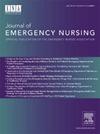Nil Per Os in the Emergency Department: A Quantitative Study on Fasting Before Presumptive Emergency Surgery
IF 2.3
4区 医学
Q2 EMERGENCY MEDICINE
引用次数: 0
Abstract
Introduction
Nil per os is a common precautionary practice in emergency departments for patients with suspected need for emergency surgery. However, this practice may lead to prolonged fasting periods, which can negatively affect patient outcomes. This study aimed to evaluate the necessity and appropriateness of nil per os for patients in the emergency department.
Methods
A retrospective quantitative observational study was conducted, analyzing 41,983 patient visits from 2 emergency departments in 2023. The study focused on surgical, orthopedic, and neurological chief complaints, where nil per os was commonly implemented. We assessed the negative predictive value of emergency surgery within specified time intervals (<6 hours and <12 hours after arrival) solely based on time from arrival in combination with surgical priorities, chief complaints, and triage priorities according to the Rapid Emergency Triage and Treatment System.
Results
Among the 41,983 included patients, 6.1% (n = 2561) underwent emergency surgery. The negative predictive value for emergency surgery within the specified time intervals was highest for Rapid Emergency Triage and Treatment System priorities 3, 4, and 5 (>99%), indicating a very low likelihood of emergency surgery within 6 to 12 hours for these patients. Rapid Emergency Triage and Treatment System priority 1 had the lowest negative predictive value, approximately 80% to 90%.
Discussion
The study indicates that the routine practice of nil per os upon arrival at the emergency department is often unwarranted, particularly for those not classified as Rapid Emergency Triage and Treatment System priority 1. These findings highlight the need for updated guidelines to ensure that nil per os protocols are issued based on a clear medical necessity, thereby minimizing unnecessary fasting and its associated risks.
急诊科零死亡率:假定急诊手术前禁食的定量研究
简介:零氧氧是一种常见的预防措施,在急诊科的病人怀疑需要紧急手术。然而,这种做法可能会导致禁食时间延长,从而对患者的预后产生负面影响。本研究旨在评估急诊病人使用零氧氧的必要性和适宜性。方法:采用回顾性定量观察研究,对2023年2个急诊科就诊的41983例患者进行分析。该研究的重点是外科、骨科和神经系统主诉,在这些主诉中,零/ 10通常被实施。我们在规定的时间间隔内评估了急诊手术的阴性预测值(结果:在纳入的41,983例患者中,6.1% (n = 2561)接受了急诊手术。在指定时间间隔内进行紧急手术的阴性预测值在快速紧急分诊和治疗系统优先级3,4,5中最高(>99%),表明这些患者在6至12小时内进行紧急手术的可能性非常低。快速紧急分类和处理系统优先级1的阴性预测值最低,约为80%至90%。讨论:研究表明,在到达急诊科时不进行任何手术的常规做法往往是没有根据的,特别是对于那些没有被列为快速紧急分诊和治疗系统优先级的患者。这些发现强调需要更新指南,以确保不根据明确的医疗需要发布任何禁食方案,从而最大限度地减少不必要的禁食及其相关风险。
本文章由计算机程序翻译,如有差异,请以英文原文为准。
求助全文
约1分钟内获得全文
求助全文
来源期刊
CiteScore
3.10
自引率
11.80%
发文量
132
审稿时长
46 days
期刊介绍:
The Journal of Emergency Nursing, the official journal of the Emergency Nurses Association (ENA), is committed to the dissemination of high quality, peer-reviewed manuscripts relevant to all areas of emergency nursing practice across the lifespan. Journal content includes clinical topics, integrative or systematic literature reviews, research, and practice improvement initiatives that provide emergency nurses globally with implications for translation of new knowledge into practice.
The Journal also includes focused sections such as case studies, pharmacology/toxicology, injury prevention, trauma, triage, quality and safety, pediatrics and geriatrics.
The Journal aims to mirror the goal of ENA to promote: community, governance and leadership, knowledge, quality and safety, and advocacy.

 求助内容:
求助内容: 应助结果提醒方式:
应助结果提醒方式:


